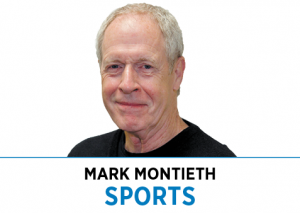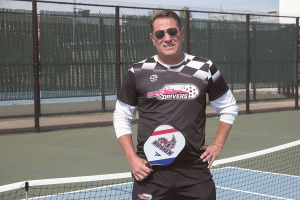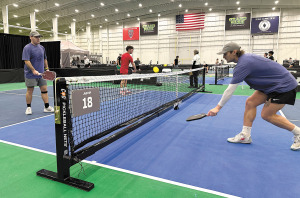Subscriber Benefit
As a subscriber you can listen to articles at work, in the car, or while you work out. Subscribe Now Pickleball’s tentacles continue to spread, reaching into every possible corner of the sporting world.
Pickleball’s tentacles continue to spread, reaching into every possible corner of the sporting world.
What began as a leisurely recreational activity, a hybrid of tennis and table tennis, is becoming increasingly serious. It’s a serious business, as any stroll through a sporting goods store proves, and it’s a serious sport that’s attracting serious athletes, as any view of a national tournament confirms.
Don’t expect it to fade into the ether, fad-like, and join hula hoops and fidget spinners as once-popular has-beens. Pickleball is now played as an intramural or club sport in schools, from junior highs to universities. College scholarships are offered for it, and many people embedded in the game in Indiana expect it to become an official high school sport under the auspices of the Indiana High School Athletic Association.
It’s also a professional sport—has been since 2019—but not just for singles and doubles play in tournaments. At least four professional leagues have emerged. One of them, Major League Pickleball, has 24 teams. Former Purdue quarterback Drew Brees is an owner of one franchise. There’s also the National Pickleball League for players 50 and over. Indianapolis has one of its 12 franchises.
The complete evolution from game to bona-fide sport seems inevitable, given pickleball’s widespread and relentless popularity. It’s easy enough for kids to learn and enjoy quickly but demanding enough to challenge accomplished athletes.
Becoming professional
Rick Witsken, for example. Formerly world-ranked in professional tennis and a two-time college All-American at Alabama, he co-founded the National Pickleball League in 2022. At 53, he’s one of the nation’s best players in his age group and was the No. 1 player of the Indy Drivers in the league’s inaugural season last year, which ended in October with a championship in Glendale, Arizona.
He also was the first player taken in the league’s draft on April 11 but had to be acquired in a trade to play for them again. Because the league has expanded from six teams to 12, none of the franchises were permitted to retain their players from the previous season. The Drivers traded two players, including former NFL quarterback Danny Wuerffel, the 1996 Heisman Trophy winner, to regain Witsken.

Each NPL team consists of eight men and eight women, and one player of each gender must be at least 60 years old. The Drivers roster includes three players from central Indiana—Witsken from Zionsville, Heather Iffert from Carmel and Ken Julian from Westfield.
“Ideally, teams will stay intact from here on out,” said Phil Cohn, who co-owns the Drivers with his wife, Paula Nahmias.
The NPL begins play on May 17. As was the case last year, no matches will be played in Indianapolis. The city doesn’t have a facility with enough courts to host the regular season’s 12-team, multiple-day matches, but the Drivers hope to host the single-elimination national championship at the end of the season. Prize money totaling $100,000 was awarded in last year’s finals.
NPL matches will be livestreamed, and Cohn said he expects the championship matches to be televised, as they were last year by the CBS Sports Network. Attendance at all matches is free, and revenue comes from sponsorships, product sales and, potentially, broadcast rights. The elite players in the league are guaranteed a salary of about $2,000 for each of the six weekend events where all 12 teams gather, but others must pay an entry fee.
Cohn said he and his wife made “a significant investment” to start the team. They lead a six-person staff of part-time employees, which happens to be the same number of front-office workers the Indiana Pacers had when they began operations in 1967. Nahmias and Cohn operate the franchise out of their commercial real estate office near the Pyramids on the northwest side of Indianapolis.
Cohn declined to state the cost of starting or operating an NPL franchise but said he believes it has doubled in value over the past year. He is open to selling all or part of it if “the right celebrity” comes along with an offer, adding he already has been approached.
Like most professional franchise owners, however, he’s not in it primarily as an investment.
“It’s a love affair for me,” he said. “We enjoy the whole process. It’s fun to get behind a team. When you go to these matches, it’s remarkable the drama that’s involved.”
In high schools
Professional teams rely on healthy feeder systems to lift their level of play, and those for pickleball are growing rapidly. Witsken, for example, directed an intramural program for 20 players at Zionsville Middle School last year. He expected about 30 for Wednesday’s callout. Pickleball is now a club sport at the school; his team has a match scheduled against Fishers and hopes to have others.
It’s a humble beginning, but Witsken expects pickleball to blossom at all competitive levels as an outgrowth of its recreational revolution.
“I think it’s going to be an Olympic sport and a legitimate middle school and high school sport, and colleges will be recruiting players,” Witsken said. “And I would be shocked if it doesn’t become an IHSAA sport.”
For that to happen, pickleball must first meet the requirements to become an emerging sport. They include having at least 20 member schools willing to offer it, submitting rules and a scheduling format, and providing data on injuries, participation in other states, diversity of participants, and letters of support from coaching organizations and associations within the sport.
The IHSAA added two sports, girls wrestling and boys volleyball, as emerging sports in 2022. They are likely to be approved as official sports at a meeting later this month, according to Sports Information Director Jason Wille.
Soccer is the most recent sport to be added to the IHSAA’s roster, in 1994, although flag football (2018) and track and field (2013) were included by a special waiver for learning-disabled students.
Collegiate opportunities
Pickleball has become a club sport at most Division I colleges. At Butler, Lisa Farley has directed its growth from an activity within the physical education program in 2010 to a dedicated class to a club sport that began play a year ago. The initial callout for participants attracted more than 100 students.
It has played just one interscholastic match, against Michigan State in Fort Wayne. It was supposed to play Indiana University’s club team last Saturday, but IU canceled.
Facilities are the primary obstacle to pickleball’s becoming a full-fledged sport in schools. Tape can be placed on tennis courts to create pickleball dimensions, but that’s impractical on a regular basis. Tennis courts can be lined permanently, but tennis programs push back against that because they want the courts available for their matches and practices and for coaches to give lessons.

Butler has four outdoor pickleball courts and has lined the basketball courts in its recreation center to create four more, but access to those is limited. Whether indoors or out, it’s difficult to fit 100 players into four courts. Farley said discussions have taken place to use the West Indy Racquet Club for practices and matches, but it’s time for pickleball’s popularity to be factored into facility considerations.
“Tennis might have to move over, honestly,” she said.
Farley said the Carmel Racquet Club now has more members playing pickleball than tennis. Which reminds her of a bumper sticker she saw recently: “Pickleball: Making tennis courts great again.”
The best evidence of pickleball’s growing place within the collegiate athletic landscape played out at Grand Park Sports Campus in Westfield Jan. 3-7, when the Association of Pickleball Players sponsored the U.S. Collegiate Championship. It attracted 22 schools, 26 teams (some brought more than one team) and 116 players. It has a contract to host championships for two more years.
Utah Tech University won the initial title and received $12,000 in scholarship funds, out of an overall pool of $50,000. Utah Tech, from St. George, Utah, is the first college to feature scholarships for pickleball players, although they are privately funded by UCP Holdings. Four players have received funds to cover six of their credit hours.
Farley, who coached a team of Butler players in the event, said she saw a glimpse of the future over those five days.
“It’s hard for me to believe they won’t make it into a varsity sport at some point,” she said.•
__________
Montieth, an Indianapolis native, is a longtime newspaper reporter and freelance writer. He is the author of three books: “Passion Play: Coach Gene Keady and the Purdue Boilermakers,” “Reborn: The Pacers and the Return of Pro Basketball to Indianapolis,” and “Extra Innings: My Life in Baseball,” with former Indianapolis Indians President Max Schumacher.
Please enable JavaScript to view this content.

Now we get it into the Olympics.